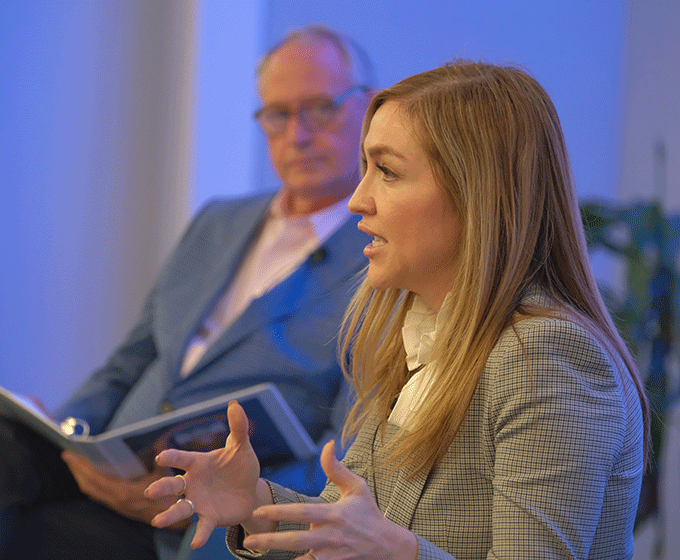
UTSA president Taylor Eighmy (left) and greater:SATX CEO Jenna Saucedo-Herrera were among the featured speakers at the spring UIDP conference this week at San Pedro I.
MAY 10, 2024 — This week, UTSA hosted the spring UIDP conference entitled “Driving Research and Development through Partnerships.” The conference offered a unique opportunity for research leaders and professionals in contracting, corporate-academic engagement and workforce development across all sectors to strategize and strengthen partnerships in research and commercialization.
Participants joined practical sessions led by global thought leaders, explored challenges and opportunities, and deconstructed strategies and success stories to inform the partnership journey.
The event, which drew more than 200 participants, focused on opportunities to build and strengthen partnerships in university-industry research collaboration, such as preparing early researchers for success in sponsored research, the role industry can play in curriculum development to enhance workforce education and current challenges in research security.
Participants represented companies, institutions and government agencies with a shared interest in driving innovative research programs in key technology areas to boost economic development.
UIDP is a nonprofit association of research universities and innovation companies from around the world. The association aims to support its members to identify strategic and tactical issues impacting university-industry relations, find practical solutions and develop effective approaches to working together across sectors. In addition to these services, UIDP also hosts conferences and workshops throughout the year.
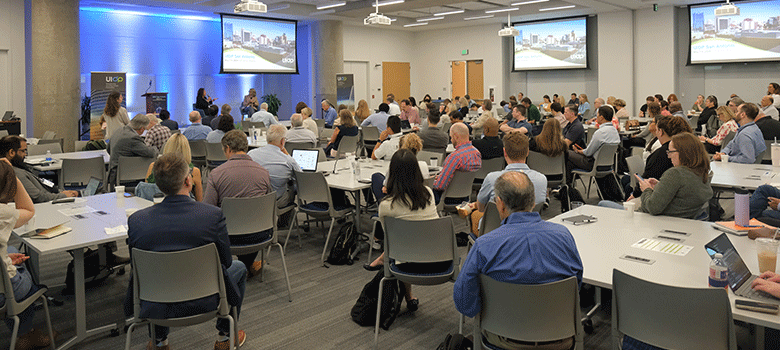
This week, UTSA welcomed more than 200 participants to San Pedro I for the spring UIDP conference, an event focused on opportunities to build and strengthen partnerships in university-industry research collaboration.
The conference came at an important time in a changing dynamic in research and development.
“We see increasing interest and investment from government agencies in research projects that involve partnerships between universities, industry and government, particularly initiatives for use-inspired and translational research,” said JoAnn Browning, UTSA interim vice president for research. “Federal agencies are calling upon us to break out of our academic silos and do more in partnership, as well as to connect with the greater community and focus on workforce development. UTSA is committed to responding to that call and cultivating partnerships that meet these needs, and that’s why we’re thrilled to be working with UIDP to strategize and foster those relationships.”
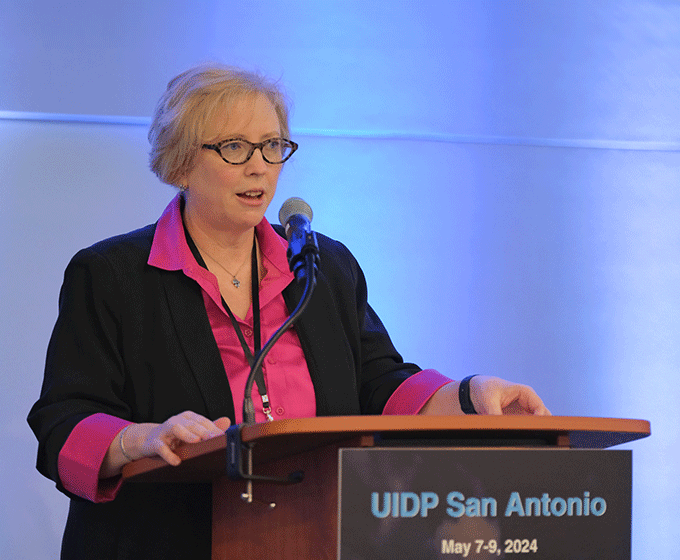 UTSA’s JoAnn Browning spoke at the conference.
UTSA’s JoAnn Browning spoke at the conference.The conference included a talk from Browning on the types of partnerships that are becoming more necessary and more frequently leveraged. “We see an infusion of funding for projects that are broader in scope and contribute to workforce development,” she said. “To achieve this, universities also need to partner with undergraduate, community colleges and even K-12 programs.”
Tony Boccanfuso, UIDP president and CEO, spoke about the need for collaboration between universities and industry partners to achieve mutual goals, including workforce development.
“Companies working in partnership with universities play a critical role as communities seize these new opportunities to grow and strengthen the innovation ecosystem,” Boccanfuso said. “Large-scale government awards now require industry and academia to align in partnership around shared goals for cross-sector research and workforce development.”
There are several reasons for this shift in funding prioritization, Boccanfuso explained. Additional investment by external funders in the U.S. and abroad has been authorized, but in some cases, such as the U.S. CHIPS and Science Act, funding levels have fallen short of expectations. As non-discretionary support takes a larger share of government funding, there is less available for science and technology.
Boccanfuso also noted that the private sector is subject to changes due to economic factors and business sector adjustments, which can affect support for sponsored research. A strategic approach to university-industry collaboration can mitigate the effects of market swings and enable research leaders to take advantage of opportunities as they arise. Industry can play a critical role in helping universities grow their research enterprise by helping academic partners garner large federal awards and becoming active participants in these partnership opportunities. Industry partners, in turn, can leverage the research developments and talent emerging from these collaborations to reach their business goals.
Rod McSherry, UTSA associate vice president for innovation and economic development, lauded the economic impacts of these partnerships.
“The bond between university researchers and industry partners is a critical component of stimulating economic growth in a community,” he said. McSherry oversees the Valdez Institute for Economic Development, which had a direct economic impact of $2.6 billion in FY 2023 and has created 58,000 jobs in the Texas economy.
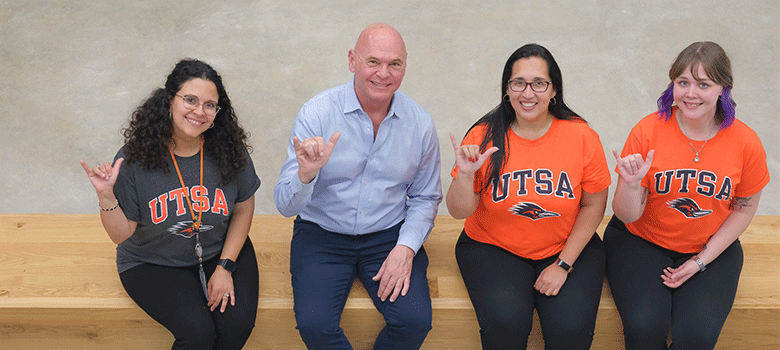
UTSA’s Rod McSherry (second from left) moderated a discussion featuring the Association of University Research Parks on the role of university research parks as hubs for University-Industry collaborations and catalysts for economic growth in Texas.
“UIDP and its members continuously explore the most effective and impactful ways for these partners to create institutional cultures of collaboration, unlocking the practical and applied uses of technologies and putting them to work in the economy,” McSherry added. “As an economic developer, I firmly believe that the interface between technology developer and technology user is one of the most critical ingredients for a community’s economic development and growth.”
During the conference, McSherry moderated a discussion featuring the Association of University Research Parks (AURP) on the role of university research parks as hubs for University-Industry (U-I) collaborations and catalysts for economic growth in Texas.
“Stanford University launched the world’s first research park in 1951,” McSherry said. “In the 70 years since then, research parks and incubators have been key tools in bringing both mature and start-up industries together with academia. With recent support from the federal government through the CHIPS and Science Act, these tech hubs have propelled economic growth through research and commercialization activities.”
The conference was held at San Pedro I, UTSA’s newest facility. The building was designed to provide a central hub for workforce development, cross-sector collaboration, and interdisciplinary scholarship and research. It facilitates industry connections for faculty and students by centralizing key programs and labs in downtown San Antonio.
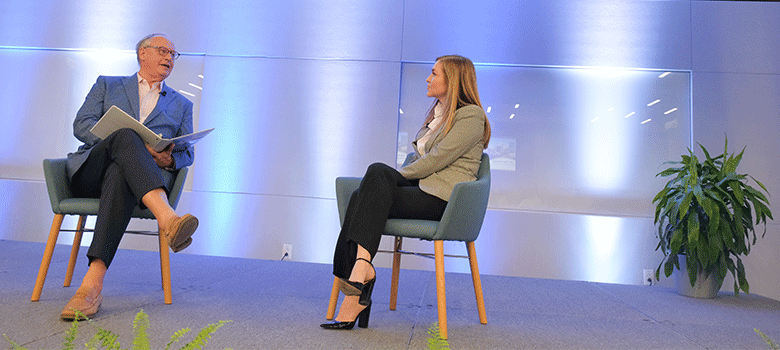
UTSA President Taylor Eighmy (left) held a fireside chat with Jenna Saucedo-Herrera, CEO at greater:SATX Regional Economic Partnership, focusing on the unique ecosystem of partnerships and opportunities in San Antonio.
“We’re fortunate to have a unique ecosystem in San Antonio that allows for strategic collaboration between government, private and public sector, and academia to advance our collective goals and strengthen the economic development efforts for the region and state,” UTSA president Taylor Eighmy said. “To support that ecosystem, we’ve intentionally developed a nexus of innovation at San Pedro I to further foster these partnerships and serve as a catalyst for the growth and impact we all want to realize.”
Eighmy held a fireside chat with Jenna Saucedo-Herrera, CEO at greater:SATX Regional Economic Partnership focusing on the unique ecosystem of partnerships and opportunities in San Antonio.
“San Antonio has a vibrant economy driven by industries in national security, medicine and health, manufacturing, and fintech to name a few,” he said. “Our city is also home to some powerhouse research organizations like SwRI, TBRI, UT Health San Antonio, and UTSA. This unique ecosystem presents an abundance of opportunities for U-I partnerships.”
As the conference host, UTSA showcased several of its leading-edge technology collaborations with industry, including university research centers and institutes such as MATRIX: The AI Consortium for Human Well-Being, the Brain Health Consortium, the National Security Collaboration Center and the Cybersecurity Manufacturing Innovation Institute. Participants had the opportunity to tour the CyManII Cybersecurity for Manufacturing Hub at Port San Antonio and view their Mobile Training Vehicle, which brings cybersecurity manufacturing training to businesses across Texas.
UTSA Today is produced by University Communications and Marketing, the official news source of The University of Texas at San Antonio. Send your feedback to news@utsa.edu. Keep up-to-date on UTSA news by visiting UTSA Today. Connect with UTSA online at Facebook, Twitter, Youtube and Instagram.
Move In To COLFA is strongly recommended for new students in COLFA. It gives you the chance to learn about the Student Success Center, campus resources and meet new friends!
Academic Classroom: Lecture Hall (MH 2.01.10,) McKinney Humanities BldgWe invite you to join us for Birds Up! Downtown, an exciting welcome back event designed to connect students with the different departments at the Downtown Campus. Students will have the opportunity to learn about some of the departments on campus, gain access to different resources, and collect some giveaways!
Bill Miller PlazaCome and celebrate this year's homecoming at the Downtown Campus with food, games, giveaways, music, and more. We look forward to seeing your Roadrunner Spirit!
Bill Miller PlazaThe University of Texas at San Antonio is dedicated to the advancement of knowledge through research and discovery, teaching and learning, community engagement and public service. As an institution of access and excellence, UTSA embraces multicultural traditions and serves as a center for intellectual and creative resources as well as a catalyst for socioeconomic development and the commercialization of intellectual property - for Texas, the nation and the world.
To be a premier public research university, providing access to educational excellence and preparing citizen leaders for the global environment.
We encourage an environment of dialogue and discovery, where integrity, excellence, respect, collaboration and innovation are fostered.